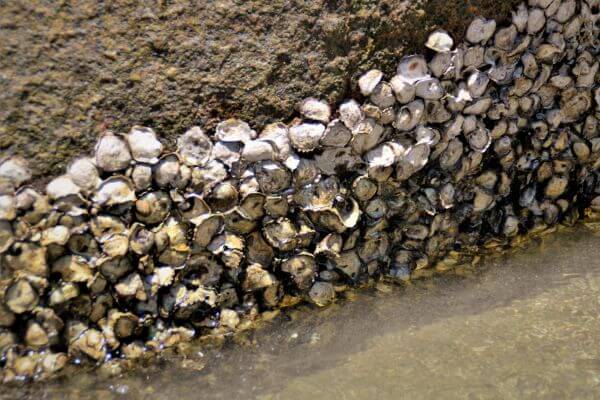Invasive barnacles are crustacean species that are transported to new regions through maritime traffic or human activities that involve water and settle in an area that is not natural for them, competing with native species for space, food and other resources. Also known as cirripeds or pedunculates.
Some species are capable of rapidly proliferating and adapting to different environmental conditions, allowing them to occupy new habitats and spread over ever larger areas. They can attach to underwater structures such as ships, pipelines and oil rig pillars, increasing the risk of damage and more frequent maintenance.
In this article, we will learn about the most problematic species and their negative impacts on marine ecosystems and the human activities that depend on them.

What are the Invasive Barnacle Species?
Here are some of the most problematic species:
- Green barnacle (Hemigrapsus sanguineus): Native to the Western Pacific, this species has been found in various areas of the east coast of the United States and northern Europe. It is able to survive in a wide variety of environments, competing with native species for space and resources.
- Caravel Barnacle (Megabalanus coccopoma): Also known as the Guinean Barnacle, this invasive species is native to the Indian and Pacific Oceans. It has been introduced to several areas, including the Caribbean and the Gulf of Mexico, where it has competed with native species for space and resources.
- Coastal European Barnacle (Balanus improvisus): It is native to the Atlantic Ocean and has spread to various areas of Europe, Asia and North America. It is able to adapt to a wide variety of environmental conditions and has been linked to changes in the structure of coastal ecosystems.
- Pacific Barnacle (Crassostrea gigas): This species of oyster has been introduced to many locations around the world for farming purposes, but has become an invasive species in some areas. It is able to compete with native species for space and resources and can alter the structure of marine ecosystems.
- Pacific Mexican Barnacle (Chthamalus challengeri): This invasive crustacean is native to the Western Pacific and has established itself in several areas of North America and Europe. It is able to adapt to a wide variety of environmental conditions and can compete with native species for space and resources.
Importantly, there are many other invasive barnacle species, each with their own ecological and economic impacts. The spread of these species must be closely monitored to minimize their negative effects on marine ecosystems and human activities.
What are the Impacts of invasive barnacles?
Barnacles or pedunculates have caused several negative impacts on marine ecosystems around the world. Some of the main impacts include:
- Competition for space: they tend to grow quickly and in large numbers, competing for space with other marine species and often outgrowing them. This can lead to reduced biodiversity and significant changes in ecosystem composition.
- Economic damage: they can cause significant economic damage to sectors such as fishing and aquaculture, as they can clog networks and damage farming equipment. Furthermore, the presence of barnacles in ports and ships can lead to delays and financial losses.
- Alteration of habitats: they can alter marine habitats, modifying the physical and chemical characteristics of the environment. This can affect species that depend on these environments to survive, leading to population declines and even local extinction.
- Exotic species: they are exotic species, that is, they are not native to the region in which they are established. This can lead to an ecological imbalance, as invasive species may not have natural predators or natural enemies that can control their growth and spread.
- Accelerated propagation: they have an accelerated reproduction capacity and high dissemination rate, which can further increase the negative impacts they cause on marine ecosystems. Therefore, it is important to monitor and control the presence of these species to minimize their negative effects.
- Competition for resources: they can compete with other marine species for resources, such as food and space. This can lead to a decrease in resource availability and affect the survival of other species, leading to an ecological imbalance.
- Economic damage: In addition to environmental impacts, invasive barnacles can also cause significant economic damage. They can damage structures such as vessels, pipelines and aquaculture equipment, leading to maintenance and repair costs. In addition, they can affect fishing and tourism, which depend on marine resources and healthy environments.
- Health risks: some species may be carriers of pathogenic organisms that may pose risks to public health. In addition, they can also cause skin irritation and allergic reactions in people who come into contact with them.
- Unknown impacts: much remains to be discovered about the impacts of invasive barnacles on marine ecosystems. Some species may have negative effects that have not yet been identified or fully understood, which reinforces the importance of monitoring and controlling the presence of these species worldwide.
How to control proliferation?
Prevention is the best way to control proliferation. Control can be done with preventive measures, such as regular inspections of ship hulls and other submerged surfaces to detect the presence of barnacles. They can be removed from surfaces with brushes and high pressure water jets before they become set. Application of antifouling coatings to ships and structures can also help reduce barnacle adhesion.
In addition, it is important to develop laws and regulations to control the introduction of invasive species into marine ecosystems. Port authorities and governments must work together to implement effective control and prevention measures, such as ballast water discharge bans and ballast water treatments to kill the organisms present. There are several organizations around the world working to raise awareness and combat invasive barnacles, one of which is:
Global Invasive Species Database (GISD): is an online tool that provides information about invasive species around the world, and helps to raise awareness about these species and the impacts they can cause.
Public awareness is also important to encourage individuals and businesses to adopt practices that prevent the spread of invasive species. Globalization and human activity are the main causes of the spread of barnacles. By better understanding barnacle species and their impacts, it will be possible to work together to protect marine ecosystems and preserve the biological diversity of the oceans. Ocean conservation is essential to ensure the survival of marine species and human well-being.

